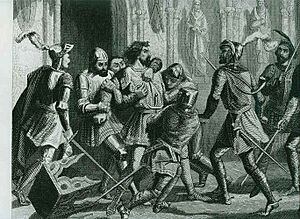Bernat de Rocafort facts for kids
Bernat de Rocafort was an important leader of the Catalan Company, a group of soldiers who fought in the Byzantine Empire in the early 1300s. He led the Company from 1307 until 1309.
Contents
Early Life and Joining the Company
Bernat de Rocafort came from a simple background, possibly from Valencia. Before 1303, he was in charge of a group of soldiers guarding two castles in Calabria for King Robert of Naples. When King Robert didn't pay him and his men, Bernat decided to join the Catalan Company.
In 1303, he brought 200 cavalry (soldiers on horseback) and 1000 almogàvers (lightly armed foot soldiers) to the Company. He quickly became their seneschal, which was like a chief manager or commander. He took over this role from Corberán de Alet. In August 1303, Bernat led the almogàvers in the Battle of Ania, while Roger de Flor led the cavalry.
Becoming the Main Leader
After Roger de Flor was killed by order of the Byzantine emperor Michael IX Palaiologos, the Catalans chose Berenguer d'Entença as their new leader. They took control of the fortress of Gallipoli. However, Entença was soon captured by a fleet from Genoa. Because of this, Rocafort was chosen to lead the Company, with a group of twelve advisors to help him.
Under Rocafort's leadership, the Catalans won battles against the Byzantines. They also raided and took valuable things from many cities in Thrace. Their strength grew when 3,800 Turkish soldiers joined them. Many of these Turkish soldiers later became Christians.
Challenges to His Power
Rocafort's position as leader faced challenges. Entença was eventually freed from captivity. When Entença returned, he was killed by Rocafort's relatives.
Rocafort also convinced the Company to refuse offers from King Frederick III of Sicily. King Frederick wanted to control the Company and sent his cousin, Prince Ferdinand of Majorca, to take over. Prince Ferdinand arrived in Greece, but the Catalans would not accept him. So, he had to return to Sicily. He was joined by Ramon Muntaner, who wrote down the history of the Catalan Company.
Moving West and Big Plans
After causing a lot of damage in Thrace, the Company had to move west in June 1307 to find new supplies. They traveled through Thrace and Macedonia. In August, they settled in the old, empty city of Kassandreia on the Chalcidice peninsula. From there, they continued their raids, even plundering the monasteries of Mount Athos in the summer of 1308.
Bernat de Rocafort had cut ties with the Crown of Aragon. To make his own power stronger, he swore loyalty to Thibaut de Cepoy, who represented Charles of Valois. However, Rocafort still held the real power. He began to dream of becoming an independent ruler. He wanted to capture Thessalonica and bring back the old Crusader kingdom there. He even had a royal seal made, showing Saint Demetrios, the city's patron saint, and a royal crown. He also wanted to rule over the Duchy of Athens. He talked about marrying the sister of the duke, Guy II de la Roche. Guy II sent people to Kassandreia and thought about using the Catalans to help his wife's claims to the nearby Principality of Achaea.
However, Venice did not like these plans. Venice saw the Catalans as a danger to its own colonies in Greece. The marriage talks did not lead to anything.
Downfall and Aftermath
Rocafort's rule became very strict, and the Company grew tired of him. He was removed from power and arrested. He was then handed over to Thibaut de Cepoy. Cepoy was worried about staying with the Catalans any longer. He secretly left in the middle of the night with Rocafort as his prisoner and sailed to Naples.
In Naples, King Robert of Naples put Rocafort in the dungeons of Aversa. Rocafort was left there to die of hunger. Meanwhile, the Catalans were angry about their leader's sudden departure. They changed their minds and killed the fourteen captains who had led the revolt against Rocafort. No new single leader was chosen. Instead, they elected a committee of four men, two from the cavalry and two from the infantry, to lead them along with the existing council of twelve.
Sources
See also
 In Spanish: Bernat de Rocafort para niños
In Spanish: Bernat de Rocafort para niños


